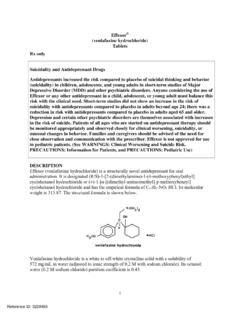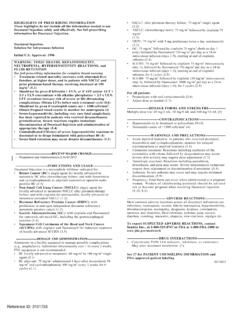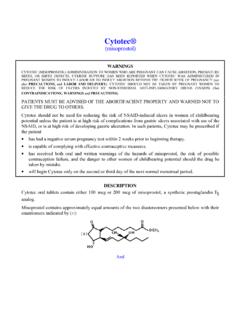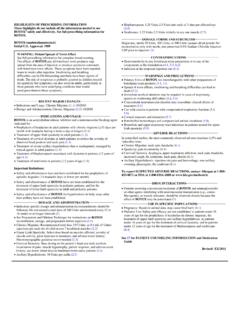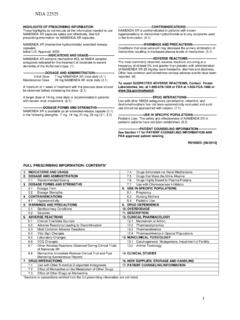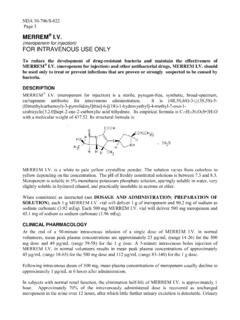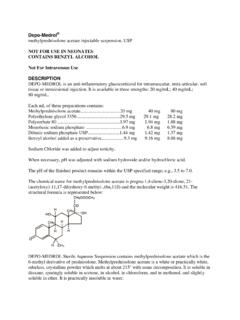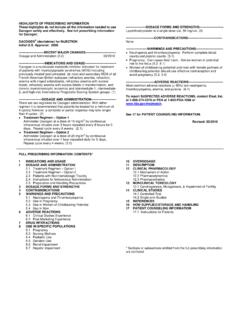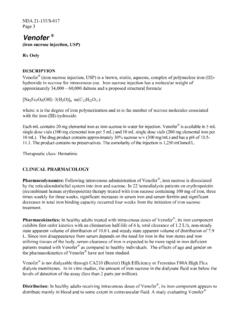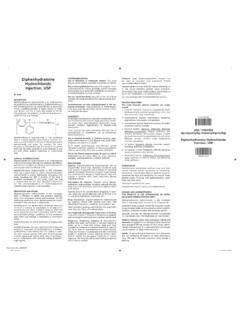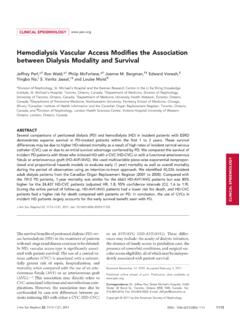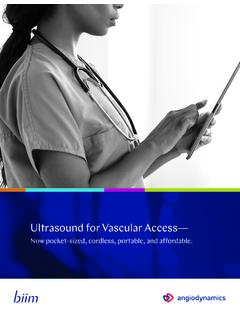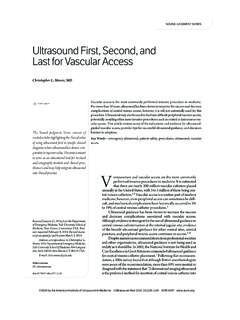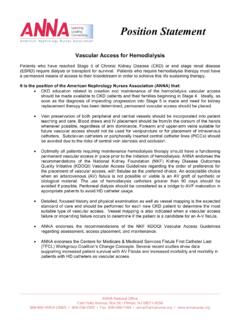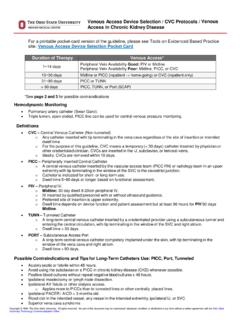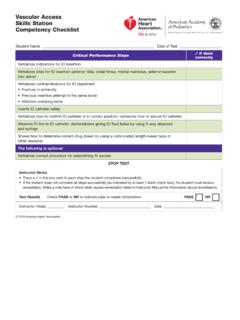Transcription of Percutaneous catheter for creation of an arteriovenous ...
1 Food & Drug Administration 10903 New Hampshire Avenue D o c I D # 0 4 0 1 7 . 0 2 . 0 8 Silver Spring, MD 20993 Avenu Medical, Inc. Ms. Rebecca Pine Regulatory Consultant 27123 Calle Arroyo, Suite 2101 San Juan Capistrano, CA 92675 Re: DEN170004 Trade/Device Name: Ellipsys vascular access System Regulation Number: 21 CFR Regulation Name: Percutaneous catheter for creation of an arteriovenous fistula for hemodialysis access Regulatory Class: Class II Product Code: PQK Dated: January 9, 2017 Received: January 10, 2017 Dear Ms. Pine: The Center for Devices and Radiological Health (CDRH) of the Food and Drug Administration (FDA) has completed its review of your De Novo request for classification of the Ellipsys vascular access System, a prescription device under 21 CFR Part with the following indications for use: The Ellipsys System is indicated for the creation of a proximal radial artery to perforating vein anastomosis via a retrograde venous access approach in patients with a minimum vessel diameter of and less than of separation between the artery and vein at the fistula creation site who have chronic kidney disease requiring dialysis.
2 FDA concludes that this device should be classified into Class II. This order, therefore, classifies the Ellipsys vascular access System, and substantially equivalent devices of this generic type, into Class II under the generic name Percutaneous catheter for creation of an arteriovenous fistula for hemodialysis access . FDA identifies this generic type of device as: Percutaneous catheter for creation of an arteriovenous fistula for hemodialysis access . This device is a single use Percutaneous catheter system that creates an arteriovenous fistula (AVF) in the arm of patients with chronic kidney disease who need hemodialysis. Section 513(f)(2) of the Food, Drug and Cosmetic Act (the FD&C Act) was amended by section 607 of the Food and Drug Administration Safety and Innovation Act (FDASIA) on July 9, 2012. This law provides two options for De Novo classification. First, any person who receives a "not substantially equivalent" (NSE) determination in response to a 510(k) for a device that has not been previously classified under the Act may, June 22, 2018 Page 2 - Rebecca Pine DEN170004 request FDA to make a risk-based classification of the device under section 513(a)(1) of the Act.
3 On December 13, 2016, the 21st Century Cures Act removed a requirement that a De Novo request be submitted within 30 days of receiving an NSE determination. Alternatively, any person who determines that there is no legally marketed device upon which to base a determination of substantial equivalence may request FDA to make a risk-based classification of the device under section 513(a)(1) of the Act without first submitting a 510(k). FDA shall, within 120 days of receiving such a request, classify the device. This classification shall be the initial classification of the device. Within 30 days after the issuance of an order classifying the device, FDA must publish a notice in the Federal Register announcing the classification. On January 10, 2017, FDA received your De Novo requesting classification of the Ellipsys vascular access System. The request was submitted under section 513(f)(2) of the FD&C Act. In order to classify the Ellipsys vascular access System into class I or II, it is necessary that the proposed class have sufficient regulatory controls to provide reasonable assurance of the safety and effectiveness of the device for its intended use.
4 After review of the information submitted in the De Novo request, FDA has determined that, for the previously stated indications for use, the Ellipsys vascular access System can be classified in class II with the establishment of special controls for class II. FDA believes that class II (special) controls provide reasonable assurance of the safety and effectiveness of the device type. The identified risks and mitigation measures associated with the device type are summarized in the following table: Table 1 Identified Risks to Health and Mitigation Measures Identified Risks to Health Mitigation Measures Unintended vascular or tissue injury Non-clinical performance testing Animal testing Clinical performance testing Labeling Adverse hemodynamic effects Non-clinical performance testing Animal testing Clinical performance testing Labeling Failure to create a durable fistula that is usable for hemodialysis Animal testing Clinical performance testing Use of the device adversely impacts future vascular access sites Clinical performance testing Labeling Adverse tissue reaction Biocompatibility evaluation Labeling Infection Sterilization validation Shelf life testing Labeling Electrical malfunction or interference leading to electrical shock, device failure, or inappropriate activation Non-clinical performance testing Electrical safety testing Electromagnetic compatibility (EMC)
5 Testing Software malfunction leading to device failure or inappropriate activation Software verification, validation, and hazard analysis In combination with the general controls of the FD&C Act, the Percutaneous catheter for creation of an arteriovenous fistula for hemodialysis access is subject to the following special controls: Page 3 - Rebecca Pine DEN170004 (1) Clinical performance testing must evaluate: (i) The ability to safely deliver, deploy, and remove the device; (ii) The ability of the device to create an arteriovenous fistula; (iii) The ability of the arteriovenous fistula can attain a blood flow rate and diameter suitable for hemodialysis; (iv) The ability of the fistula to be used for vascular access for hemodialysis; (v) The patency of the fistula; and (vi) The rates and types of all adverse events. (2) Animal testing must demonstrate that the device performs as intended under anticipated conditions of use. The following performance characteristics must be assessed: (i) Delivery, deployment, and retrieval of the device; (ii) Compatibility with other devices labeled for use with the device; (iii) Patency of the fistula; (iv) Characterization of blood flow at the time of the fistula creation procedure and at chronic follow-up; and (v) Gross pathology and histopathology assessing vascular injury and downstream embolization.
6 (3) Non-clinical performance testing must demonstrate that the device performs as intended under anticipated conditions of use. The following performance characteristics must be tested: (i) Simulated-use testing in a clinically relevant bench anatomic model to assess the delivery, deployment, activation, and retrieval of the device; (ii) Tensile strengths of joints and components; (iii) Accurate positioning and alignment of the device to achieve fistula creation ; and (iv) Characterization and verification of all dimensions. (4) Electrical performance, electrical safety, and electromagnetic compatibility (EMC) testing must be performed for devices with electrical components. (5) Software verification, validation, and hazard analysis must be performed for devices that use software. (6) All patient-contacting components of the device must be demonstrated to be biocompatible. (7) Performance data must demonstrate the sterility of the device components intended to be provided sterile.
7 (8) Performance data must support the shelf life of the device by demonstrating continued sterility, package integrity, and device functionality over the identified shelf life. (9) Labeling for the device must include: (i) Instructions for use; (ii) Identification of system components and compatible devices; (iii) Expertise needed for the safe use of the device; (iv) A detailed summary of the clinical testing conducted and the patient population studied; and Page 4 - Rebecca Pine DEN170004 (v) A shelf life and storage conditions. In addition, this is a prescription device and must comply with 21 CFR Section 510(m) of the FD&C Act provides that FDA may exempt a class II device from the premarket notification requirements under section 510(k) of the FD&C Act, if FDA determines that premarket notification is not necessary to provide reasonable assurance of the safety and effectiveness of the device type. FDA has determined premarket notification is necessary to provide reasonable assurance of the safety and effectiveness of the device type and, therefore, the device is not exempt from the premarket notification requirements of the FD&C Act.
8 Thus, persons who intend to market this device type must submit a premarket notification containing information on the Percutaneous catheter for creation of an arteriovenous fistula for hemodialysis access they intend to market prior to marketing the device. Please be advised that FDA's decision to grant this De Novo request does not mean that FDA has made a determination that your device complies with other requirements of the FD&C Act or any Federal statutes and regulations administered by other Federal agencies. You must comply with all the FD&C Act's requirements, including, but not limited to: registration and listing (21 CFR Part 807); labeling (21 CFR Part 801); medical device reporting (reporting of medical device-related adverse events) (21 CFR 803) for devices or postmarketing safety reporting (21 CFR 4, Subpart B) for combination products (see ); good manufacturing practice requirements as set forth in the quality systems (QS) regulation (21 CFR Part 820) for devices or current good manufacturing practices (21 CFR 4, Subpart A) for combination products; and if applicable, the electronic product radiation control provisions (Sections 531-542 of the FD 21 CFR 1000-1050.)
9 A notice announcing this classification order will be published in the Federal Register. A copy of this order and supporting documentation are on file in the Dockets Management Branch (HFA-305), Food and Drug Administration, 5630 Fishers Lane, Room 1061, Rockville, MD 20852 and are available for inspection between 9 and 4 , Monday through Friday. As a result of this order, you may immediately market your device as described in the De Novo request, subject to the general control provisions of the FD&C Act and the special controls identified in this order. For comprehensive regulatory information about medical devices and radiation-emitting products, please see Device Advice ( ) and CDRH Learn ( ). Additionally, you may contact the Division of Industry and Consumer Education (DICE) to ask a question about a specific regulatory topic. See the DICE website ( ) for more information or contact DICE by email or phone (1-800-638-2041 or 301-796-7100).
10 Page 5 - Rebecca Pine DEN170004 If you have any questions concerning the contents of the letter, please contact Ryan Randall at 240-402-6590. Sincerely, Angela C. Krueger Deputy Director, Engineering and Science Review Office of Device Evaluation Center for Devices and Radiological Health
